Katherine J. Mimnaugh
Leaning-Based Control of an Immersive-Telepresence Robot
Aug 22, 2022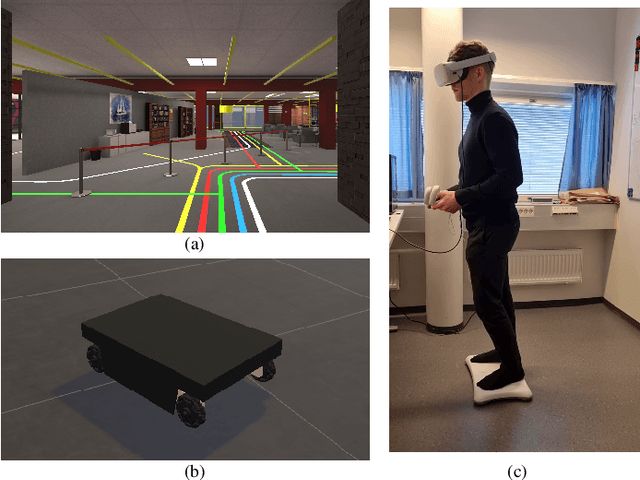

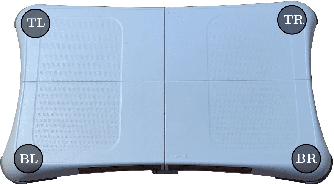
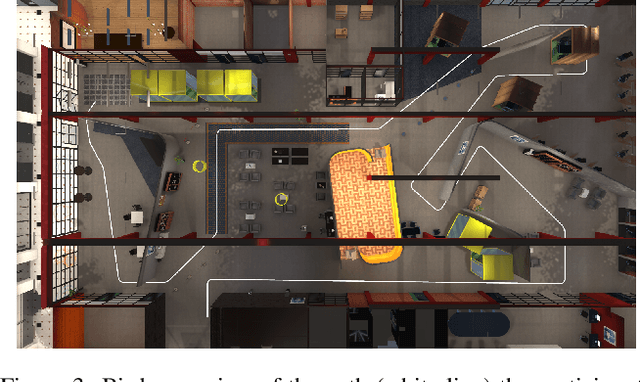
Abstract:In this paper, we present an implementation of a leaning-based control of a differential drive telepresence robot and a user study in simulation, with the goal of bringing the same functionality to a real telepresence robot. The participants used a balance board to control the robot and viewed the virtual environment through a head-mounted display. The main motivation for using a balance board as the control device stems from Virtual Reality (VR) sickness; even small movements of your own body matching the motions seen on the screen decrease the sensory conflict between vision and vestibular organs, which lies at the heart of most theories regarding the onset of VR sickness. To test the hypothesis that the balance board as a control method would be less sickening than using joysticks, we designed a user study (N=32, 15 women) in which the participants drove a simulated differential drive robot in a virtual environment with either a Nintendo Wii Balance Board or joysticks. However, our pre-registered main hypotheses were not supported; the joystick did not cause any more VR sickness on the participants than the balance board, and the board proved to be statistically significantly more difficult to use, both subjectively and objectively. Analyzing the open-ended questions revealed these results to be likely connected, meaning that the difficulty of use seemed to affect sickness; even unlimited training time before the test did not make the use as easy as the familiar joystick. Thus, making the board easier to use is a key to enable its potential; we present a few possibilities towards this goal.
HI-DWA: Human-Influenced Dynamic Window Approach for Shared Control of a Telepresence Robot
Mar 05, 2022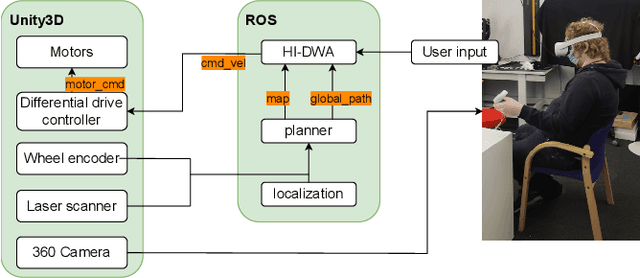
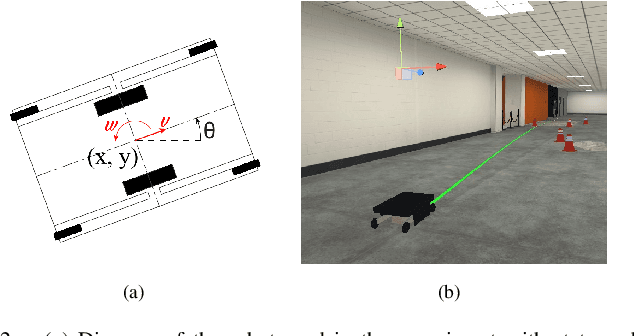
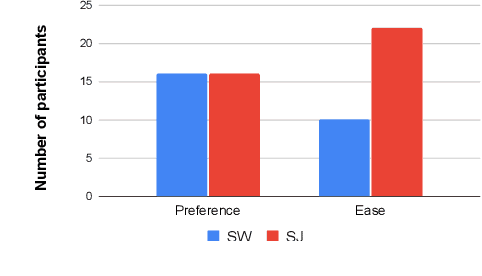
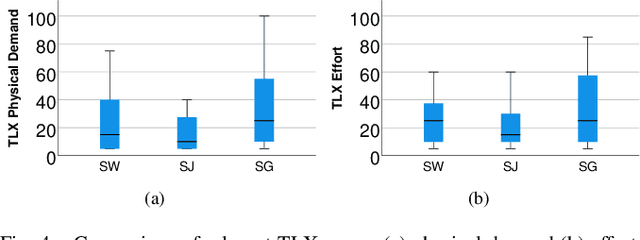
Abstract:This paper considers the problem of enabling the user to modify the path of a telepresence robot. The robot is capable of autonomously navigating to the goal indicated by the user, but the user might still want to modify the path without changing the goal, for example, to go further away from other people, or to go closer to landmarks she wants to see on the way. We propose Human-Influenced Dynamic Window Approach (HI-DWA), a shared control method aimed for telepresence robots based on Dynamic Window Approach (DWA) that allows the user to influence the control input given to the robot. To verify the proposed method, we performed a user study (N=32) in Virtual Reality (VR) to compare HI-DWA with switching between autonomous navigation and manual control for controlling a simulated telepresence robot moving in a virtual environment. Results showed that users reached their goal faster using HI-DWA controller and found it easier to use. Preference between the two methods was split equally. Qualitative analysis revealed that a major reason for the participants that preferred switching between two modes was the feeling of control. We also analyzed the affect of different input methods, joystick and gesture, on the preference and perceived workload.
A Study of Preference and Comfort for Users Immersed in a Telepresence Robot
Mar 05, 2022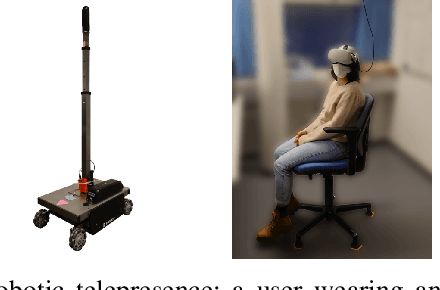
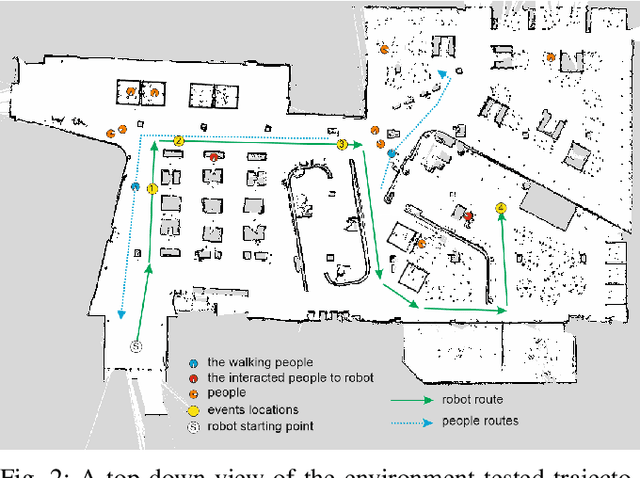

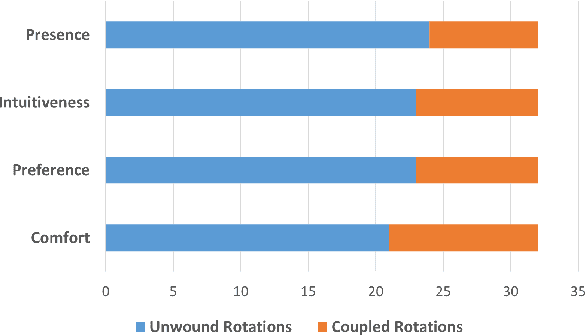
Abstract:In this paper, we show that unwinding the rotations of a user immersed in a telepresence robot is preferred and may increase the feeling of presence or "being there". By immersive telepresence, we mean a scenario where a user wearing a head-mounted display embodies a mobile robot equipped with a 360{\deg} camera in another location, such that the user can move the robot and communicate with people around it. By unwinding the rotations, the user never perceives rotational motion through the head-mounted display while staying stationary, avoiding sensory mismatch which causes a major part of VR sickness. We performed a user study (N=32) on a Dolly mobile robot platform, mimicking an earlier similar study done in simulation. Unlike the simulated study, in this study there is no significant difference in the VR sickness suffered by the participants, or the condition they find more comfortable (unwinding or automatic rotations). However, participants still prefer the unwinding condition, and they judge it to render a stronger feeling of presence, a major piece in natural communication. We show that participants aboard a real telepresence robot perceive distances similarly suitable as in simulation, presenting further evidence on the applicability of VR as a research platform for robotics and human-robot interaction.
Augmenting Immersive Telepresence Experience with a Virtual Body
Feb 02, 2022



Abstract:We propose augmenting immersive telepresence by adding a virtual body, representing the user's own arm motions, as realized through a head-mounted display and a 360-degree camera. Previous research has shown the effectiveness of having a virtual body in simulated environments; however, research on whether seeing one's own virtual arms increases presence or preference for the user in an immersive telepresence setup is limited. We conducted a study where a host introduced a research lab while participants wore a head-mounted display which allowed them to be telepresent at the host's physical location via a 360-degree camera, either with or without a virtual body. We first conducted a pilot study of 20 participants, followed by a pre-registered 62 participant confirmatory study. Whereas the pilot study showed greater presence and preference when the virtual body was present, the confirmatory study failed to replicate these results, with only behavioral measures suggesting an increase in presence. After analyzing the qualitative data and modeling interactions, we suspect that the quality and style of the virtual arms, and the contrast between animation and video, led to individual differences in reactions to the virtual body which subsequently moderated feelings of presence.
Unwinding Rotations Improves User Comfort with Immersive Telepresence Robots
Jan 07, 2022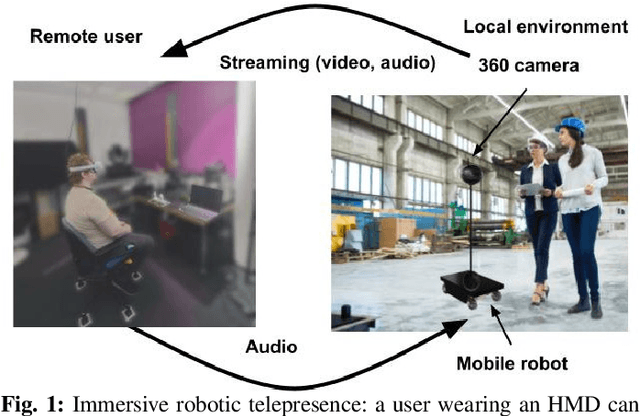
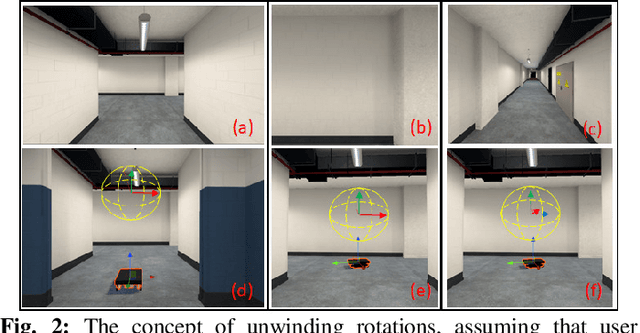

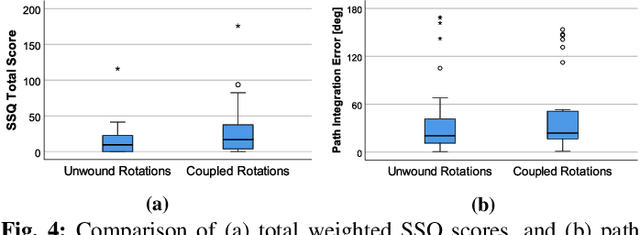
Abstract:We propose unwinding the rotations experienced by the user of an immersive telepresence robot to improve comfort and reduce VR sickness of the user. By immersive telepresence we refer to a situation where a 360\textdegree~camera on top of a mobile robot is streaming video and audio into a head-mounted display worn by a remote user possibly far away. Thus, it enables the user to be present at the robot's location, look around by turning the head and communicate with people near the robot. By unwinding the rotations of the camera frame, the user's viewpoint is not changed when the robot rotates. The user can change her viewpoint only by physically rotating in her local setting; as visual rotation without the corresponding vestibular stimulation is a major source of VR sickness, physical rotation by the user is expected to reduce VR sickness. We implemented unwinding the rotations for a simulated robot traversing a virtual environment and ran a user study (N=34) comparing unwinding rotations to user's viewpoint turning when the robot turns. Our results show that the users found unwound rotations more preferable and comfortable and that it reduced their level of VR sickness. We also present further results about the users' path integration capabilities, viewing directions, and subjective observations of the robot's speed and distances to simulated people and objects.
Comfort and Sickness while Virtually Aboard an Autonomous Telepresence Robot
Sep 09, 2021



Abstract:In this paper, we analyze how different path aspects affect a user's experience, mainly VR sickness and overall comfort, while immersed in an autonomously moving telepresence robot through a virtual reality headset. In particular, we focus on how the robot turns and the distance it keeps from objects, with the goal of planning suitable trajectories for an autonomously moving immersive telepresence robot in mind; rotational acceleration is known for causing the majority of VR sickness, and distance to objects modulates the optical flow. We ran a within-subjects user study (n = 36, women = 18) in which the participants watched three panoramic videos recorded in a virtual museum while aboard an autonomously moving telepresence robot taking three different paths varying in aspects such as turns, speeds, or distances to walls and objects. We found a moderate correlation between the users' sickness as measured by the SSQ and comfort on a 6-point Likert scale across all paths. However, we detected no association between sickness and the choice of the most comfortable path, showing that sickness is not the only factor affecting the comfort of the user. The subjective experience of turn speed did not correlate with either the SSQ scores or comfort, even though people often mentioned turning speed as a source of discomfort in the open-ended questions. Through exploring the open-ended answers more carefully, a possible reason is that the length and lack of predictability also play a large role in making people observe turns as uncomfortable. A larger subjective distance from walls and objects increased comfort and decreased sickness both in quantitative and qualitative data. Finally, the SSQ subscales and total weighted scores showed differences by age group and by gender.
Analysis of User Preferences for Robot Motions in Immersive Telepresence
Mar 05, 2021



Abstract:This paper considers how the motions of a telepresence robot moving autonomously affect a person immersed in the robot through a head-mounted display. In particular, we explore the preference, comfort, and naturalness of elements of piecewise linear paths compared to the same elements on a smooth path. In a user study, thirty-six subjects watched panoramic videos of three different paths through a simulated museum in virtual reality and responded to questionnaires regarding each path. Preference for a particular path was influenced the most by comfort, forward speed, and characteristics of the turns. Preference was also strongly associated with the users' perceived naturalness, which was primarily determined by the ability to see salient objects, the distance to the walls and objects, as well as the turns. Participants favored the paths that had a one meter per second forward speed and rated the path with the least amount of turns as the most comfortable.
Defining Preferred and Natural Robot Motions in Immersive Telepresence from a First-Person Perspective
Feb 25, 2021

Abstract:This paper presents some early work and future plans regarding how the autonomous motions of a telepresence robot affect a person embodied in the robot through a head-mounted display. We consider the preferences, comfort, and the perceived naturalness of aspects of piecewise linear paths compared to the same aspects on a smooth path. In a user study, thirty-six subjects (eighteen females) watched panoramic videos of three different paths through a simulated museum in virtual reality and responded to questionnaires regarding each path. We found that comfort had a strong effect on path preference, and that the subjective feeling of naturalness also had a strong effect on path preference, even though people consider different things as natural. We describe a categorization of the responses regarding the naturalness of the robot's motion and provide a recommendation on how this can be applied more broadly. Although immersive robotic telepresence is increasingly being used for remote education, clinical care, and to assist people with disabilities or mobility complications, the full potential of this technology is limited by issues related to user experience. Our work addresses these shortcomings and will enable the future personalization of telepresence experiences for the improvement of overall remote communication and the enhancement of the feeling of presence in a remote location.
Human Perception-Optimized Planning for Comfortable VR-Based Telepresence
Feb 25, 2020



Abstract:This paper introduces an emerging motion planning problem by considering a human that is immersed into the viewing perspective of a remote robot. The challenge is to make the experience both effective (such as delivering a sense of presence) and comfortable (such as avoiding adverse sickness symptoms, including nausea). We refer to this challenging new area as human perception-optimized planning and propose a general multiobjective optimization framework that can be instantiated in many envisioned scenarios. We then consider a specific VR telepresence task as a case of human perception-optimized planning, in which we simulate a robot that sends 360 video to a remote user to be viewed through a head-mounted display. In this particular task, we plan trajectories that minimize VR sickness (and thereby maximize comfort). An A* type method is used to create a Pareto-optimal collection of piecewise linear trajectories while taking into account criteria that improve comfort. We conducted a study with human subjects touring a virtual museum, in which paths computed by our algorithm are compared against a reference RRT-based trajectory. Generally, users suffered less from VR sickness and preferred the paths created by the presented algorithm.
 Add to Chrome
Add to Chrome Add to Firefox
Add to Firefox Add to Edge
Add to Edge